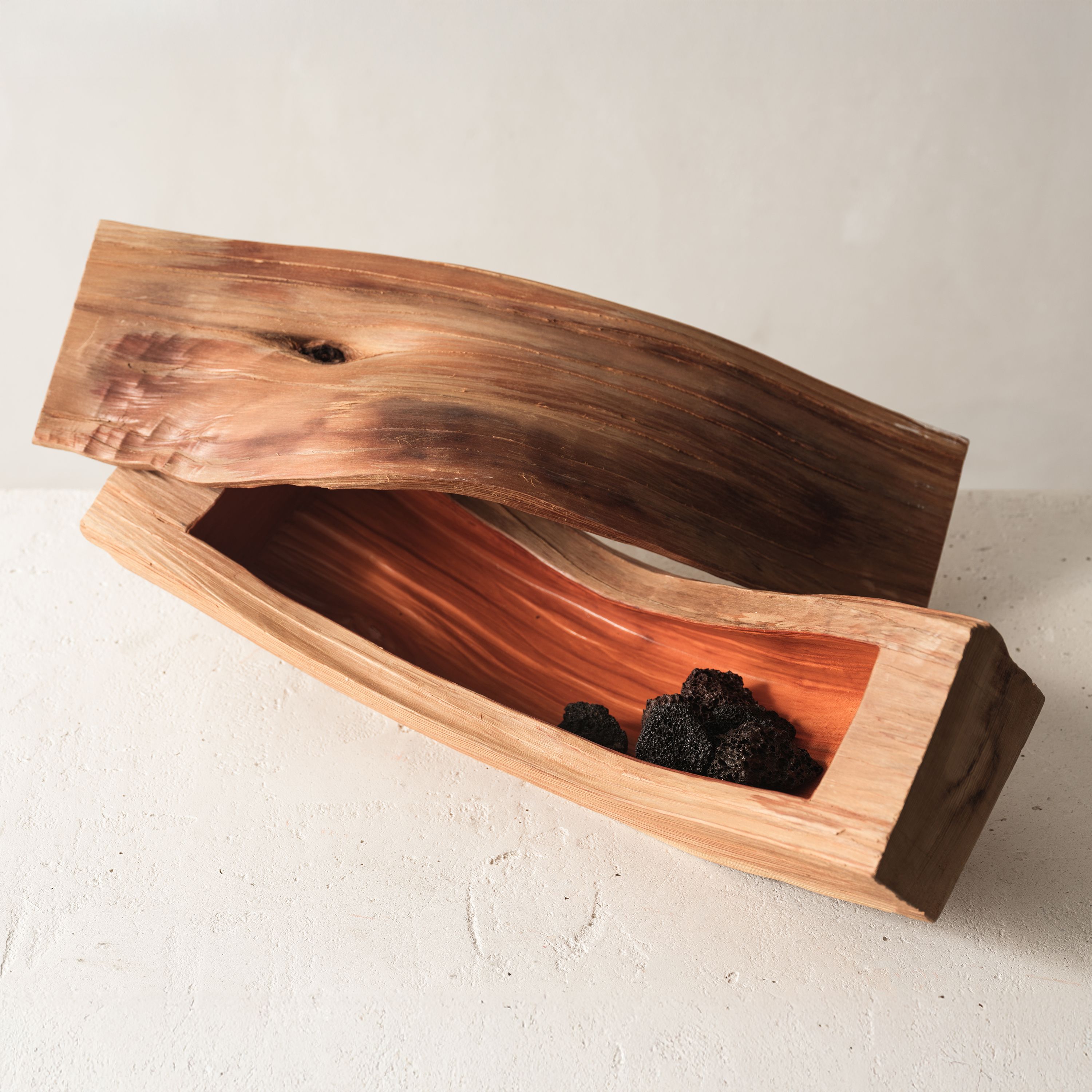
CEDAR BOWL

Designer/Manufacturer
Shuji NakagawaDescription
Hand-crafted in Japan by master wood crafter Shuji Nakagawa, this piece belongs to the artist’s sought-after series of marquetry work and contemporary wooden buckets (called ki-oke in Japan). Each piece is made using a technique developed 700 years ago during the Muromachi era. During the Edo period, households started to use wooden buckets for bathing rituals or for storing rice and miso. The buckets remain ubiquitous amongst Japanese households today, although their designs have evolved and they are now used for various purposes, such as champagne coolers, bathtubs, or decorative objects.
Shuji Nakagawa
Shuji Nakagawa
From his remote studio located in the serene countryside of Lake Shiga near Kyoto, Shuji Nakagawa carries on the fine wood crafting traditions of the region and time-honored techniques that were passed down from his ancestors.
Hailing from a long lineage of marquetry masters, seventh-generation Nakagawa honed his craft under the mentoring of his father, Living National Treasure, Kiyotsugu Nakagawa, in Kyoto. Nakagawa has since built a comprehensive body of work of his own and established his personal practice in the serene countryside of Lake Shiga near Kyoto.
Though rooted in craftsmanship legacy and cultural heritage, Nakagawa's work breaks from tradition. Expanding upon the time-honored techniques that were passed down from his father, the artist taps into his individuality, voicing his artistic ideas through nonfunctional sculptural forms of larger scale. Created in 2023, this series was highlighted in the Kyoto Kyocera Museum exhibition 'Visionaries' curated by Noriko Kawakami last spring. From monumental sculptures to small objects of traditional functionality, Nakagawa’s pieces embody the artist’s deep respect for his organic medium — wood —, his artisanal dexterity, and the culture of humility that is shared among Japan’s master craftsmen.
His entire body of work highlights the essence and natural beauty of various local wood species. Often the artist chooses to work with Jindai-Sugi — a Japanese cedar sourced from Northern Japan's forests that symbolizes the interconnectedness of humanity and the natural world. Its weathered bark and intricate patterns evoke a sense of harmony where the passage of time is celebrated rather than feared.
The wood crafter explains the virtues of different wood species and why one may have been historically selected over another for certain purposes. “Sawara cypress has a soft smell and the ability to absorb water well, that is why we usually use it for rice keepers. The Hinoki cypress, however, has a strong scent. It’s not suitable for food and drink containers. Instead, its medicinal virtues make it a good species to use for wooden bathtubs and other bathroom elements” says Shuji-san.
Nakagawa's wood pieces are sought after both for the remarkably soft surfaces he is able to achieve and for the seamless curves of their silhouettes. His work has been exhibited in museums across Japan and Europe and is part of significant private and institutional collections.
Shuji Nakagawa
From his remote studio located in the serene countryside of Lake Shiga near Kyoto, Shuji Nakagawa carries on the fine wood crafting traditions of the region and time-honored techniques that were passed down from his ancestors.
Hailing from a long lineage of marquetry masters, seventh-generation Nakagawa honed his craft under the mentoring of his father, Living National Treasure, Kiyotsugu Nakagawa, in Kyoto. Nakagawa has since built a comprehensive body of work of his own and established his personal practice in the serene countryside of Lake Shiga near Kyoto.
Though rooted in craftsmanship legacy and cultural heritage, Nakagawa's work breaks from tradition. Expanding upon the time-honored techniques that were passed down from his father, the artist taps into his individuality, voicing his artistic ideas through nonfunctional sculptural forms of larger scale. Created in 2023, this series was highlighted in the Kyoto Kyocera Museum exhibition 'Visionaries' curated by Noriko Kawakami last spring. From monumental sculptures to small objects of traditional functionality, Nakagawa’s pieces embody the artist’s deep respect for his organic medium — wood —, his artisanal dexterity, and the culture of humility that is shared among Japan’s master craftsmen.
His entire body of work highlights the essence and natural beauty of various local wood species. Often the artist chooses to work with Jindai-Sugi — a Japanese cedar sourced from Northern Japan's forests that symbolizes the interconnectedness of humanity and the natural world. Its weathered bark and intricate patterns evoke a sense of harmony where the passage of time is celebrated rather than feared.
The wood crafter explains the virtues of different wood species and why one may have been historically selected over another for certain purposes. “Sawara cypress has a soft smell and the ability to absorb water well, that is why we usually use it for rice keepers. The Hinoki cypress, however, has a strong scent. It’s not suitable for food and drink containers. Instead, its medicinal virtues make it a good species to use for wooden bathtubs and other bathroom elements” says Shuji-san.
Nakagawa's wood pieces are sought after both for the remarkably soft surfaces he is able to achieve and for the seamless curves of their silhouettes. His work has been exhibited in museums across Japan and Europe and is part of significant private and institutional collections.

View the Collection

KI-OKE JINDAI-SUGI

KI-OKE SAWARA

DUNE OMBRE

Yorishiro Box XVII

Yorishiro Box XVI

Yorishiro XXIII

Yorishiro XXIV

Yorishiro XXII

Yorishiro XXI

Yorishiro XIX

Yorishiro XX

Yorishiro XVIII

Marquetry Jewelry Box

Marquetry Box

Moon IV

Yorishiro XIV

Yorishiro Box XV

Yorishiro XIII

Yorishiro XII

Yorishiro XI

Yorishiro X

Yorishiro IX

Yorishiro VIII

Yorishiro VII

Yorishiro VI

Yorishiro V

Yorishiro IV

Yorishiro III

Yorishiro II

Yorishiro I

WAVE Triangle

WAVE Square

WAVE Pentagon

Moon III

Moon II

Moon I

Marquetry Rounded

Marquetry Dent

Marquetry Spread

Outer Shell

Octagonal Cone

Giant Crater

INDIGO TABLE

KURO-GAKI PERSIMMON TRAY

KONOHA HINOKI

KONOHA JINDAI-SUGI

KOYA MAKI LOW

SHIZUKU HINOKI

INDIGO TABLE

MISUMI HINOKI


